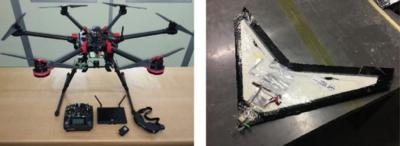More Than Half Of The Agency's Drones Were Acquired Without Proper Approvals
NASA's Office of Inspector General has released a report calling for better oversight of the agency's drone program.

In the audit, the OIG assessed NASA’s research efforts to help safely integrate UAS into the national airspace as well as the Agency’s use of its own drone resources. To complete this work, NASA, FAA, and other relevant officials were interviewed; UAS inventory at NASA Centers were inspected; and relevant purchase records and transfer documentation were reviewed.
Overall, the OIG found that while NASA effectively supports the FAA’s efforts to introduce aerial drones into the national airspace, the Agency’s oversight of its own UAS assets needs improvement. Agency policy written in 2009 and updated in 2015 details procedures for procuring UAS and tracking their use in NASA’s property system, including the need for prior approval before purchasing and the use of tracking barcodes on all UAS. However, ineffective Center implementation of these policies has led to poor inventory control and unauthorized acquisition of UAS. For example, we found that 231 of the 410 (56 percent) UAS acquired since 2009 were obtained without the required prior approvals.
In addition, inaccurate and incomplete information about UAS in NASA’s property system hinders the Agency’s ability to effectively share unmanned aircraft assets between Centers. Center officials are also not routinely excessing unneeded assets in a timely manner and therefore the assets are not available to other potential UAS users either within NASA or outside the Agency. Without proper prior approvals and accurate inventory, NASA officials cannot ensure that UAS meet required safety standards, increasing NASA’s risk posture if an unauthorized UAS causes damage to facilities or personal injury.

Furthermore, failure to include all UAS in the Agency’s property system renders them invisible and unavailable for use by other projects or Centers, possibly leading potential users to acquire new UAS rather than utilizing existing assets, thus wasting NASA resources.
To address the issues, the OIG recommended the Assistant Administrator for Strategic Infrastructure direct the Aircraft Management and Logistics Management Division Directors to:
- ensure that Center Directors have developed an effective process to routinely inform all potential NASA end users of procedures and logistics requirements required to obtain UAS
- create or incorporate into existing policy criteria for defining and distinguishing UAS and determining the number of UAS spare parts to maintain
- create a checklist for Center personnel to ensure proper acquisition procedures are followed for a UAS transfer, purchase, or in-house build
- reinforce barcode requirements to track all UAS
- require Centers to identify and dispose of unneeded UAS or aerial drones, or identify a reason they should be maintained
- work with Center aviation management offices to implement records management procedures to ensure that once approval has been received to obtain a UAS, all supporting documentation is filed together or cross-referenced for ease of identification.
In response to a draft of this report, NASA management concurred or partially concurred with the recommendations and described its planned actions. The OIG considers management’s comments responsive; "therefore, the recommendations are resolved and will be closed upon completion of the proposed actions and verification of corrective action plans."
(Images from NASA OIG report)
 ANN's Daily Aero-Term (04.24.24): Runway Lead-in Light System
ANN's Daily Aero-Term (04.24.24): Runway Lead-in Light System ANN's Daily Aero-Linx (04.24.24)
ANN's Daily Aero-Linx (04.24.24) Aero-FAQ: Dave Juwel's Aviation Marketing Stories -- ITBOA BNITBOB
Aero-FAQ: Dave Juwel's Aviation Marketing Stories -- ITBOA BNITBOB Classic Aero-TV: Best Seat in The House -- 'Inside' The AeroShell Aerobatic Team
Classic Aero-TV: Best Seat in The House -- 'Inside' The AeroShell Aerobatic Team Airborne Affordable Flyers 04.18.24: CarbonCub UL, Fisher, Affordable Flyer Expo
Airborne Affordable Flyers 04.18.24: CarbonCub UL, Fisher, Affordable Flyer Expo




